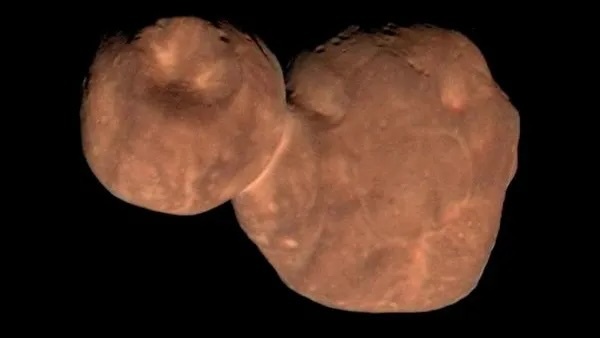10.06.2024
Scientists think the Kuiper Belt Object is a sugar world, which would also explain its reddish hue.

A composite image of Kuiper Belt Object Arrokoth. (Image credit: NASA/Johns Hopkins University Applied Physics Laboratory/Southwest Research Institute/Roman Tkachenko)
On New Year’s Day in 2019, NASA's New Horizons spacecraft radioed to Earth images of the farthest object ever explored: a snowman-shaped primordial object named Arrokoth, one of many frigid residents in the Kuiper Belt that sits beyond Neptune's orbit. The pictures revealed the surface of the two-lobed, 21-mile-wide (34-kilometer-wide) structure to be rusty red, and this mysterious hue has kept scientists puzzled ever since.
Originally, scientists proposed that radiation from solar wind and galactic cosmic rays, which routinely bombard Arrokoth's surface, somehow converts primitive ices like methanol into organic molecules that give off an ultra-red hue. Details about how this process would work, however, remained unclear.
Now, we may have some answers. A lab experiment that mimicked space radiation exposure — similar to the kind Arrokoth's surface experiences — found a sugar-rich surface may explain the object's distinct red color. To reach this conclusion, scientists led by Chaojiang Zhang of the University of Hawaii exposed a frozen specimen of methanol and carbon monoxide to high-energy electrons, which served as proxies for galactic cosmic rays that rain on Arrokoth, at doses equivalent to about 1.8 billion years of space radiation.
The simulated radiation set off a series of chemical reactions in the ice, which led to the formation of a group of carbon-rich molecules known as polycyclic aromatic hydrocarbons, or PAHs, known to be common in the universe. But interestingly, spectroscopic techniques revealed the radiation-infused ices also produced glucose, the main sugar in your blood and your body's primary source of energy. Scientists also detected allose coming out of these experiments, which is a sugar found in fruits and nuts, and glycerol, which is commonly used as a humectant in soaps to help your skin retain its moisture.
In other words, Arrokoth probably tastes sweet — and soapy.
Moreover, when viewed from space, the PAHs, glucose and other sugars would appear red, scientists reported. Sugar worlds in the Kuiper Belt like Arrokoth may have impacted Earth early in its history and ferried prebiotic molecules as well as water to our planet, providing the feedstock for biomolecules that would have been crucial for emerging life.
A paper about these findings was published in April in the journal Proceedings of the National Academy of Science.
Quelle: SC
